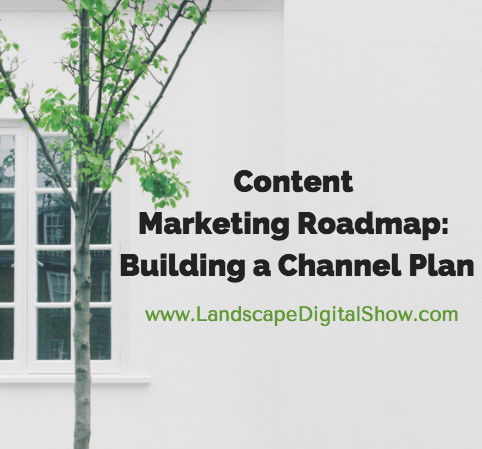Episode 49 of Landscape Digital Show reveals how to build and implement a channel plan to achieve your content marketing roadmap goals.
https://www.landscapedigitalinstitute.com/wp-content/uploads/2017/01/Ep49FinalAuph.mp3
Before you build a content marketing channel plan you need to give careful consideration to your business goals, its ideal audience, and finding and perfecting your brand story. You can get that foundation from Content Marketing Roadmap: 3 Keys to Ideal Customers.
If you know your ideal customer you know the problems they face that prevent them from choosing any company, including yours.
This is especially true for services like landscaping or lawn care because they are not a must have like healthcare, for example, but a lifestyle choice, something people simply want to have for their own enjoyment.
What is your audience hungry for that if you give it to them will move them closer to a relationship with your business?
This may be solving a small problem with your content, such as an assurance that the pesticides your company uses are safe for children and pets. Solving small problems is a strong indication that you can solve the larger ones too.
Thus, your content is like an appetizer that activates the hunger for the main course, which is your products and services. You have to show people you care about helping them, that you are capable of doing so, and that the entire experience will be one they will enjoy.
Let’s now unpack the 7 steps to building and implementing your content marketing roadmap channel plan.
#1 – Content Audit
You may not have a lot of content, but at the very least you have a website. And you probably have some print marketing materials. Start by listing everything you have created to date, with the goal of keeping that list current moving forward.
For more detail on how on this and a template to follow, check out Content Audit: Building Your Content Marketing Foundation. You won’t regret this exercise because we all forget what we published after some time and being able to access earlier content makes the present work easier.
#2 – Content Topics
The topics your content addresses should be relevant to your customers’ aspirations and challenges. For example, if you are doing high-end residential landscaping work, maintenance and upkeep is most certainly an issue to be addressed.
Our customers often told us they would only move forward with a landscape project if we promised to maintain it for them. They trusted us to design and build it, so naturally, they wanted its care to be entrusted to the same company.
#3 – Editorial Calendar
The editorial calendar will detail the specific content topics for the entire year. Most companies work with a monthly theme that’s broken down into subtopics.
#4 – Channel Plan
The channel plan can be combined with the editorial calendar to clarify which channels will receive what type of content, whether that’s long or short form, video or audio, and so on.
The channels we’re referring to are blogs, email newsletters, and all the social media channels, but there are many others.
5 – Content Ownership
The editorial calendar should specify the content ownership responsibilities, which are:
- Content Ideation or Creation
- Content Publication
- Content Promotion
It’s important to note that these respective responsibilities do not have to be owned by the same person.
#6 – Publishing Style Guidelines
It’s highly advisable to have publishing guidelines that keep the voice, style, and tone of the content consistent. This will also detail what you do and don’t do, such as using specific keywords and whether or not to link to outside content.
There are very capable virtual admins that can efficiently and economically take care of content publication and promotion for you. But, you have to provide them with guidelines that are consistent with your brand.
#7 – Analytics
The only way to get better is to measure your channel performance. At the very least you should be checking your Google Analytics to determine where your traffic is coming from and which types of content and channels are proving to be most productive.
That’s why we call this a roadmap. It’s a reliable guide, but its consistent implementation is what will lead to the accomplishment of your goals.
Show Notes
- Be sure to check the links for each of the 7 steps to get in-depth information on those respective topics.
- Never miss an episode. Subscribe to Landscape Digital Show on iTunes.
- And if you are on Facebook, please like the Landscape Digital Institute page. I’ll greatly appreciate that!
Call to Action
The call to action for this episode is to first check Content Marketing Roadmap: 3 Keys to Ideal Customers to get that necessary foundation. Then start organizing your content marketing system with the 7 steps discussed in this episode.
